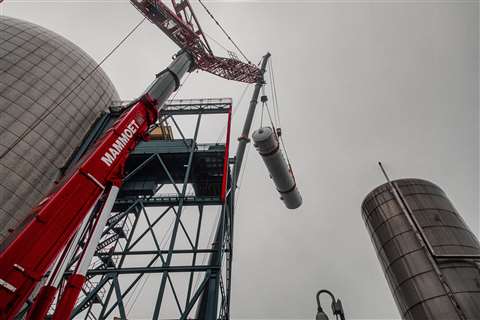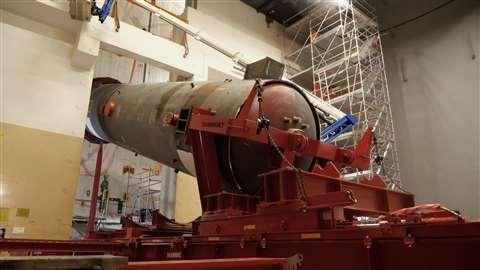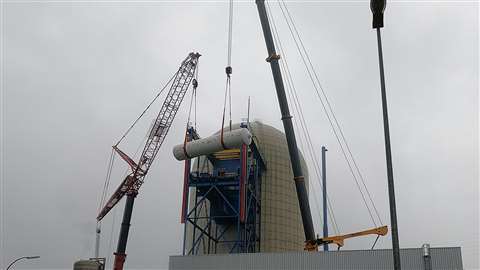Complex steam converter removal by Mammoet
13 September 2022
 Lifting in tandem to lower the converters onto waiting transports. Photo: Mammoet
Lifting in tandem to lower the converters onto waiting transports. Photo: Mammoet
The Lingen nuclear power plant in Germany is being decommissioned with the help of international specialist Mammoet.
The company removed two steam converters, each weighing around 155 tonnes, from the control area of the plant. It was a multi-discipline operation to remove them, the company said.
First, they had to be moved vertically before being laid horizontal and lifted from the building to then be placed on transporters waiting below.
“Our extensive experience from decommissioning projects enabled us to involve swiftly in the ongoing decommissioning process and develop a safe solution in a relatively short time,” said Dr Sören Müller, team leader nuclear and logistics at Mammoet Germany.
On site requirements for protection against radiation meant all tooling, equipment and 100 tonnes of fabricated steelwork had to pass radiation checks before it could be taken into the control area. It was a considerable time factor to be taken into account at the planning stage to meet the project deadline.
Strand jacks were a key element in the combined lifting and transport operation. Before work began core components, including the support strap, temporary lifting device and the skidding beam for the transverse skidding part of the job, all underwent load tests.
 Being lowered to horizontal from vertical. Note the restricted site conditions. Photo: Mammoet
Being lowered to horizontal from vertical. Note the restricted site conditions. Photo: Mammoet
To the job
For a start the support strap was installed on the first steam converter. It was installed standing in a narrow housing which made access difficult. Hydraulic climbing jacks were used to lift the unit and move it sideways.
With the support strap attached, the temporary lifting device took the load. “It was pushed out of the housing centimetre by centimetre with a skidding device and finally placed precisely onto a skidding track. The now horizontal steam converter was then rotated by 90 degrees and lowered,” Mammoet explained.
It could then be removed from the control area to a steel gantry, built several storeys high against the building’s exterior. Clearance during the operation was just a few centimetres, the company said, due to interfering edges and a narrow diameter opening.
With the steam converter removed it was lifted from this portal gantry. Lifting power was provided by 1,200- and 750-tonne capacity wheeled mobile cranes, lifting in tandem. It was then loaded for transport.
Converter number two was removed under the same procedure. After that, four sub-coolers were moved and lifted and handed over to the customer for loading into special containers.
“We were very satisfied with the technical solution and the co-operation with Mammoet. The very well planned and safe removal of the steam converters was an important step in the overall decommissioning process,” commented client Stefan Lindemann, project manager dismantling large components at RWE Nuclear in Germany.
 Lowering one of the steam converters outside the building using 1,200- and 750-tonne cranes. Photo: Mammoet
Lowering one of the steam converters outside the building using 1,200- and 750-tonne cranes. Photo: Mammoet
STAY CONNECTED


Receive the information you need when you need it through our world-leading magazines, newsletters and daily briefings.




